
UNH's Space Science Center (SSC) has a legacy of more than 100 partnerships on NASA missions and 60+ years of pioneering involvement in space research, including the development, build, and test of cutting-edge space instrumentation.
To support these endeavors, the SSC has developed state-of-the-art facilities that provide a comprehensive environment for assembly, integration, and space qualification testing. This robust infrastructure underpins our commitment to advancing space science and technology, ensuring that our collaborators and missions achieve the highest standards of performance and reliability.
Commercial entities can now access and book services at these facilities through the UNH Space Tech Hub.
Get in touch to find out more about our services.
-
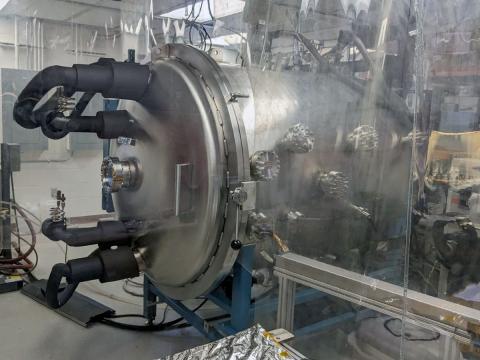 Brand name: Dynavac custom built in 2010 (built for MMS mission)
Brand name: Dynavac custom built in 2010 (built for MMS mission)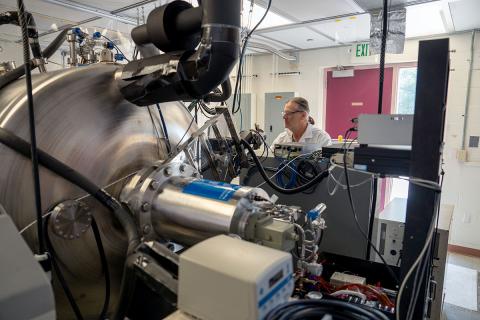
- Chamber size: 4' diameter and 5' deep (cylinder)
Interior space: 46" diameter x 60" deep - Chamber pressure: 10-7 Torr
- Temperature range: -30o to +80o C
- Platen with thermal fluid transfer system (FTS)
- Number of thermocouples for monitoring: 30 chamber thermocouples; 16 thermocouples for instrument
- Ramp rate range: typical rate 3oC/minute, but 1oC/minute is possible or even lower (just takes much longer for transitioning)
- Venting gas: liquid Nitrogen shroud
- Scavenger plate on door used for freezing contaminants onto surface
RGA scanner – 300 amu
TQCM (2000) – QCM Research
-
 Clean room specs: ISO 7, class 10000 clean room
Clean room specs: ISO 7, class 10000 clean room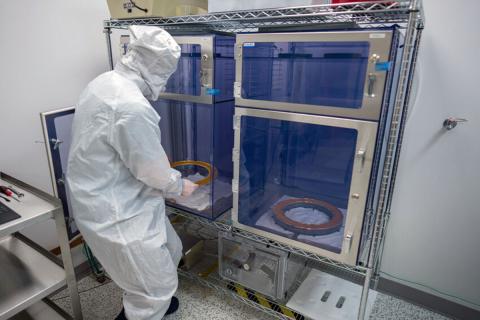
- Benches:
- ISO 5 laminar flow assembly bench
- 5 assembly benches 6' x 2.5'
- Storage:
- Clean room storage: X4 N2 and X6 N2 storage containers
- Dry, clean storage containers for component storage
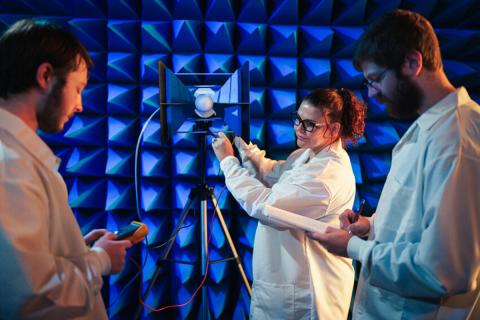

The UNH EMI/Anechoic Chamber is capable of MIL-SPEC-461 EMI/EMC and antenna radiation measurements.
Dimensions
- External: Within 17'L x 15'W x 12'H footprint
- Internal: At least 16'L x 14'W x 10'H
- Usable Space: At least 12'L x 10'W x 8'H
- Maximum UUT: 1m x 1m x 1m
General Chamber Performance
- Operating frequency range: 80 MHz – 40 GHz
- Shielding effectiveness: 100 dB to 1 GHz (verified by measurement)
MIL-SPEC Performance
- <-6dB reflectivity from 80 MHz – 250 MHz
- <-10dB reflectivity above 250 MHz
(These specs are greatly exceeded with the anechoic cones) - Test capabilities include: CE01, CE03, CMN, CS01, CS02, RE01, and RE02
Antenna Radiation Performance
- <100 dB isolation
- <2 dB ripple in quiet zone
- 3-D radiation patterns
- 0.5 to 6 GHz
- 10 lbs. DUT capacity
Miscellaneous
- 6' wide door
- Removable copper-topped MIL-SPEC bench
- APM turntable accommodation
- Waveguide ventilation
- Bulkhead connector panels
- 2x30A service with 60Hz filters & adequate lighting

BlueFors LD 250 Dilution Refrigerator
- Base temperature: <10mK
- Experimental volume: 340mm tall × 300mm diameter
- Cooling power: 16μW at 20mK and 456μW at 100mK
- Cool-down time from room temperature: ~24 hours
- Wiring:
- 12× twisted pair (Cu from RT to 4K and superconducting NbTi from 4K to the mixing chamber)
- 4× coax from RT to mixing chamber (1× superconducting NbTi between 4K and mixing chamber available)
- 1× optical fiber from RT to 4K
- 3× ports for X-ray and optical windows to experimental volume

Brand Name: Tenney Environmental Testing Chamber T10C-1.5, Serial number: 0903000051
- No vacuum
- Size: 2.5' x 2.5' x 2.5'
- Temperature range: -73o C to 200o C
- Venting: dry nitrogen
- No thermocouples inside, would have to put them on the instrument
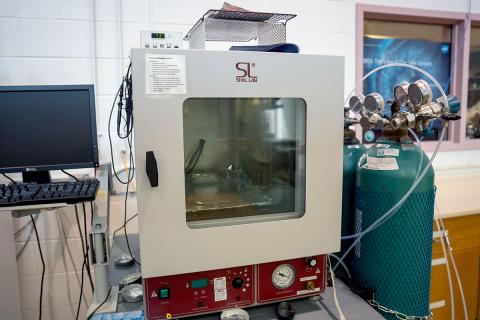
Brand Name: Shel Lab vacuum bake-out oven: Model 1445.2, S/N 03041610
- Size: 1' x 1' x 1'
- Calibrated to: 60o C (rated up to 200o C)
- Chamber pressure range: 20 mTorr (rough vacuum)
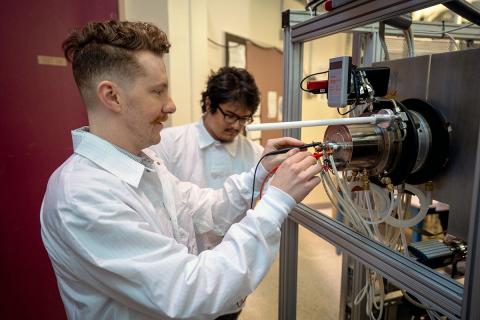
The UNH Space Plasma Laboratory (M145) houses an Ion Accelerator for calibrating space plasma instrumentation. This calibration system is comprised of a high vacuum testing chamber and a duoplasmatron ion source with an electrostatic accelerator beam line (Peabody scientific Model PS-100).
Beam Characteristics
- Energy range: 1-24 keV
- Species: H, D, He, C, N, O, Ar
- Beam size: up to ~75mm diameter
- Flux:
- Arc Discharge Mode: 1e-14 to 1e-7 A/cm
- Electron bombardment mode: 1 to 1e4 Ct/sec/cm
Instrument Test Chamber Contains
- RGA chamber cleanliness monitor
- Beam Diagnostic imaging MCP
- Three motion stages for adjusting test position
- One Newton MTN300PPV6 linear stage with 100mm of travel
- Two Newport Rv120PE rotational stages
- Optional Mu metal shroud for magnetic field background suppression
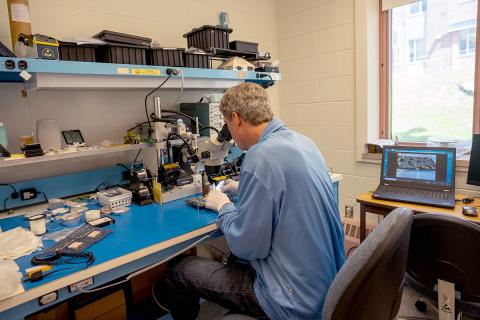
- Satisfies NASA Electrostatic Discharge (ESD), temperature, and humidity standards for manufacturing flight electronic circuit boards
- Technicians have IPC J-STD-001 Certification for Soldered Electrical and Electronic Assemblies (NASA Required Certification)
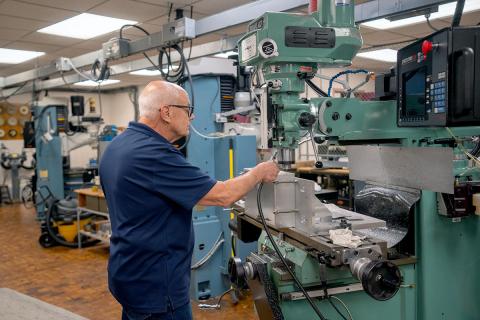
The Space Science Center Machine Shop for Flight Mechanical Assemblies contains:
- 3-Axis Proto Trak milling machines (2)
- 2-Axis Proto Trak milling machine (1)
- Proto Trak CNC lathe (1)
- Manual lathes (3)
- Calibrated inspection equipment